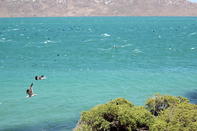Annual Pilgrimage North

The Avian Demography Unit (ADU) at the University of Cape Town has been counting the birds of Langebaan Lagoon for 30 years. When it projects its figures onto a graph, the general trend in bird numbers is downward in spite of the occasional flux between seasons. The curlew sandpiper, knot and sanderling show the greatest declines, but the grey plover and turnstone are not far behind.
For some reason, these conditions seem to be favouring the larger-bodied whimbrels and bar-tailed godwits whose numbers have increased over this time. It just goes to show how unpredictable species response can be to changing climate.
Doug Harebottle at the ADU says that, while this decline has not been linked conclusively to global climate change, it is fair to say there is a strong correlation. As with so much else, the evidence points towards the likely culprit, or at least one that is a partner in crime with many of the other factors threatening birds, in a world where increasing numbers of humans live.
Climate change is the single greatest threat to the planet's wading birds and the days of the great northern wildernesses are numbered.
Migration Wonder
Until such a time, however, the curlews of Langebaan Lagoon will continue their annual pilgrimage north, flouting all political boundaries carved into maps with ink. They will skip over border posts and bypass capitals with neither visa nor passport. They will still confound us with the wonder of their migration.
When August starts to close up shop in the Arctic, the new generation of curlews will be fattened up and ready to fly south all on their own. There will be no adults left to guide them south and to mentor them in the ways of transcontinental flight. They will tune into an instinct that has the blueprint of the night skies fixed in their heads, their senses tuned to magnetic fields, and an inherited memory of landmarks and the setting sun.
Forget bird-brained. These winged creatures will reach Langebaan Lagoon a few weeks later a whole lot more worldly than your average infant. The youngsters will arrive to find their mothers just recovering from their own trip home, having left the chicks as soon as they could stand on their own. But their fathers will have been home for a lot longer.
You see, the males only stick around in the Arctic for about two weeks, just long enough to get the eggs settled into the nest before they fly back south. Whichever way you look at it, a 28 000 km round-trip is a long way to fly to reproduce.